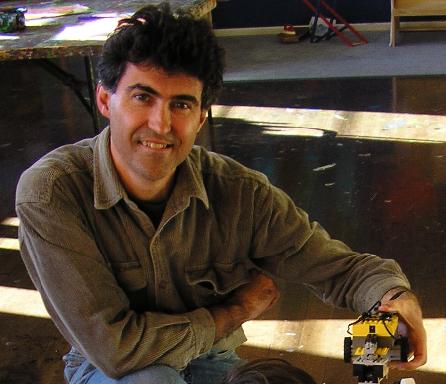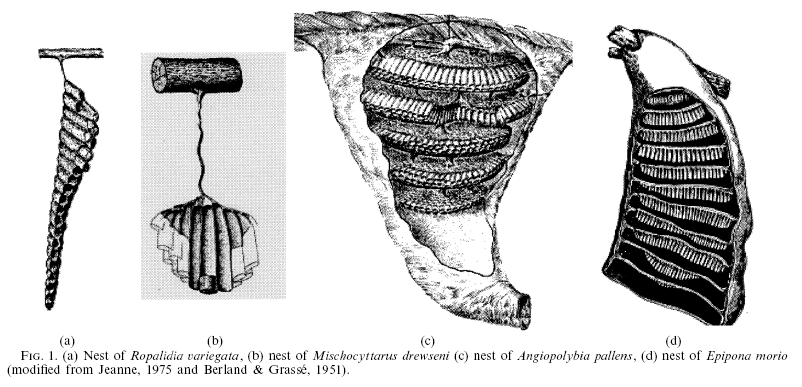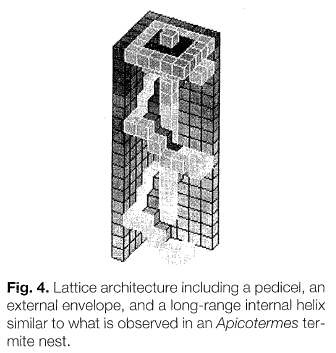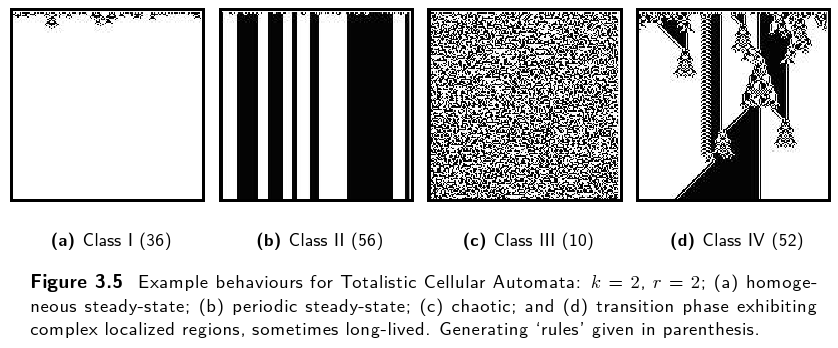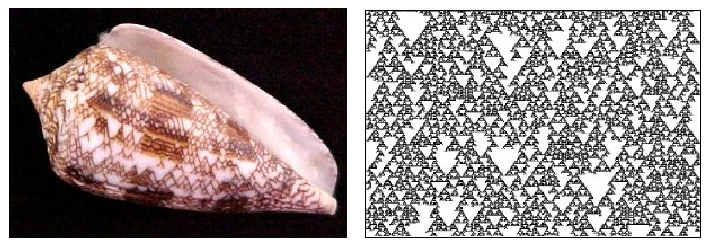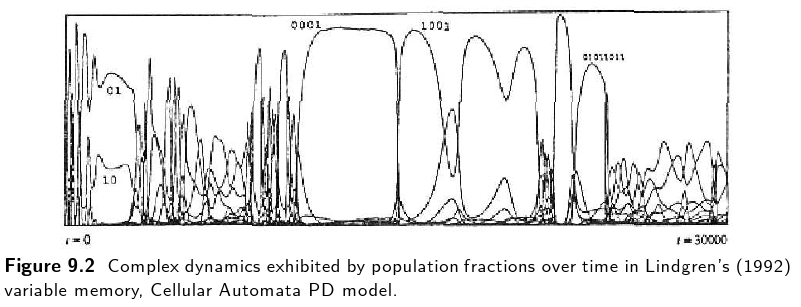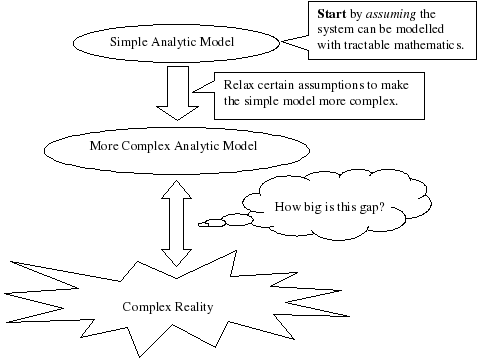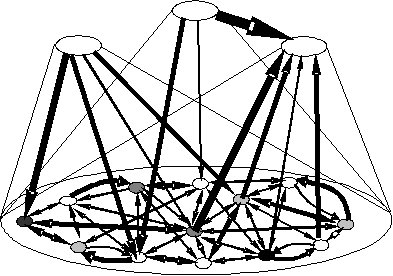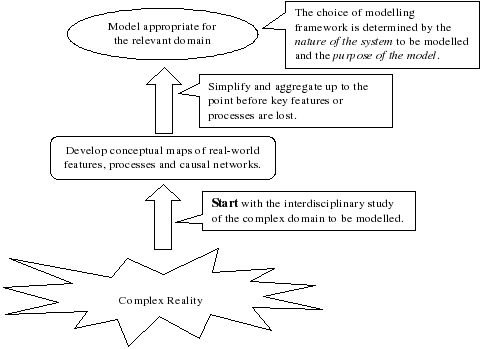| /ComplexityAndAdaptiveAgents /NetlogoPrimer /OverTheShoulderProject /Project2008 /ProjectExhibit2008 |
... or, what I learnt from the masters
The (my) masters:
And the master hub of of Complex Systems
- Founded around 1984
- By Los Alamos senior fellows
Wanted to do interesting science on hard problems without restrictions of working in the federal lab
The Approach:
- Multidisciplinary Approach to Understanding the sciences of complexity
- Pioneering Concepts
- Complex Adaptive Systems (CAS), 'SFI style economics'
- Adaptation on fitness landscapes
- Artificial life
- Internet auctions, market behavior
- Adaptive computation and computational modeling
- New network theory (e.g. NK boolean nets)
- Biological scaling (allometry)
What is a Complex System?
SFI Website
Complex systems research attempts to uncover and understand the deep commonalities that link artificial, human, and natural systems. By their very nature, these problems transcend any particular field, for example, if we understand the fundamental principles of organization, we will gain insight into the functioning of cells in biology, firms in economics, and magnets in physics. This research relies on theories and tools from across the sciences. Part of the rise of the complex systems research agenda can be tied to the use of theoretical computation as a new way to explore such systems. |
Wikipedia (16 Sep, 2008)
A complex system is a system composed of interconnected parts that as a whole exhibit one or more properties (behavior among the possible properties) not obvious from the properties of the individual parts. |
Brian Arthur (Complexity and the Economy, Science 1999)
Barring some asymptotic state or equilibrium reached, complex systems are systems in process, systems that constantly evolve and unfold over time. |
Kristian Lindgren's website
Complex systems are found at several levels in nature and society: On the microscopic level there are spin systems and other systems exhibiting long-range correlations. On mesoscopic and macroscopic scales, there are reaction-diffusion systems that give rise to complex spatio-temporal behaviour. On the societal level, for example in economic and social systems, there are interacting agents, co-operating or competing for resources. But, possibly more than in other fields, biology provides examples of how interaction of smaller components at one level give rise to new structure at higher levels of aggregation: bio-molecules, cells, organs, organisms, groups, and ecosystems. |
Key components:
Some kind of universality to the behaviour (nature, social, geological systems)
The whole is greater than the sum of the parts -- emergence and self-organization
- The system exhibits 'interesting' time-series (dynamics) (possibly open-ended)
Candidates for Complex Systems?
- The biosphere
- Ecological systems
- The stock market
- Human social interactions (e.g. culture)
- The (unplanned) economy
- Build-slip systems (self-organized criticality ...?)
Emergence & Self-Organization
What is Emergence?
Try it
NetLogo > ModelsLibrary > Biology > Flocking
Standish, R. (2001)
An emergent phenomenon is simply one that is described by atomic concepts available in the macrolanguage, but cannot be so described in the microlanguage. |
Aleksic, Z. et al., Artificial Life: Growing Complex Systems (2000)
The regular patterns that can be discriminated in domains other than the generating domain are examples of emergent phenomena. The main characteristic of an emergent phenomenon is that "it cannot exist and thus cannot be interacted with or observed at lower generating levels." (Bass,1994) It exists as the result of the aggregate behaviour of more elementary parts. |
|
The notion of emergent complex behaviour looks like a kind of miracle to some people. ... We are so accustomed to describing things we find in nature with a small number of parameters that we easily forget their composite nature We should not forget that most of the successes of natural science are connected with the explanation of obvious properties of phenomena in terms of the functioning of the component parts. |
|
It is unfortunate that the word 'emergence' has attracted a somewhat mystic flavour. In some usages it is a buzzword replacing the word novelty or creativity. Here we use it in a rather mundane way to denote relatively stable and regular structures that appear during the aggregation or formation of components. |
Really? .. Is that possible?
Bees and Ants (and shells) (may) do it ...
Try it for yourself...
Wolfram's 1D Cellular Automata
... A model of emergence from simple rules
The idea:
0 [ ][1][0][0][1][1][1][0][1][0][1][1][1][1][0][0][0] ... initial state
1 [ ][ ][ ][ ][ ][ ][ ][ ][ ][ ][ ][ ][ ][ ][ ][ ][ ]
2 [ ][ ][ ][ ][ ][ ][ ][ ][ ][ ][ ][ ][ ][ ][ ][ ][ ]
3 [ ][ ][ ][ ][ ][ ][ ][ ][ ][ ][ ][ ][ ][ ][ ][ ][ ]
4 [ ][ ][ ][ ][ ][ ][ ][ ][ ][ ][ ][ ][ ][ ][ ][ ][ ]
How to get (t+1) from (t)?
[a][b][c]
[x]
x = LOOKUP_TABLE(a + b + c)
LOOKUP_TABLE
If a+b+c is... then x is ...
0 1
1 1
2 0
etc.Try it
- Try rule 1635 ... which class does this exhibit?
NetLogo > ModelsLibrary > Computer Science > Cellular Automata > CA 1D Totalistic
Murray Gell-Mann, The Quark and the Jaguar (1994)
The most striking feature of those simulations is the emergence of complex behaviour from simple rules. Those rules imply general regularities, but the working out of an individual case exhibits special regularities in addition. |
Is that what the shells are doing?
(probably not .. more likely reaction-diffusion)
What do we learn?
'Complex behaviour' (e.g. Class IV) can emerge from simple rules
Major belief overturned: 'Complex OUT requires Complex IN' (Complex behaviour must have complex functional underpinnings)
Most of the rule space isn't interesting
Many of the rules lead to stasis (Class I), or periodicity (Class II), or randomness (Class III)
Even simple rules can lead to open-ended systems
- What?
That is, systems that keep on changing their states forever ... !!!
- What?! .. no equilibrium? .. that's right... sorry.
- That kind of system doesn't exist in reality right?!?!?
- The economy?
- Biological evolution?
- The weather?
- ...
Open-ended Models of Evolution
- Krirsten Lindgren's evolutionary model of the Prisoner's Dilemma game
- No (apparent) statis
- Phase-change behaviour
Is this related to Chaos? (and non-linear dynamics and fractals)
... yes, .. and no
YES
- Small pertubations in initial conditions can lead to amazingly complex outcomes
Non-linear dynamics certainly a feature in complex systems models, but not necessarily in the functional forms (the simple rules) themselves, but in how they aggregate over time
NO
Chaotic dynamics are a particular kind of non-linear dynamics
- There are formal tests for these dynamics, with specific asymptotic behaviours (e.g. period-doubling and the Feigenbaum number)
Complex Systems and Conventional Economics
With thanks to...
Brett Parris, Monash Econometrics |
|
The Conventional Approach
Agents:
- Perfectly informed
- Fully rational, optimizing
- Well behaved
- Infinite information processing machinery
Markets:
- Always clear
- Perfectly informed
- Goods homogeneous, or simply different
Models:
- Equilibrium approach
- Comparative statics (comparisons of different equilibrium positions)
- Dynamics well behaved
- Optimization through calculus (what do we assume here?)
.. of course, things are more complex, but we at least begin here
Where has 'conventional' economic theory come from?
... Mainly from the successes of turn of the 19th/20th C. physics
- Axiomatic formalism
Theorems deducted from the formalism
Equilibrium analysis (a.k.a. thermodynamics)
Energy considerations in all things (... utility?)
(Axioms based on experimental evidence)
Economists, trained as physicists and engineers, then turned their minds to the economy...
This cohort included William Stanley Jevons, Leon Walras, Francis Ysidro Edgeworth, Irving Fischer, Vilfredo Pareto, and a whole host of others. They succeeded where others had failed because they had uniformly become impressed with a single mathematical metaphor that they were all familiar with, that of equilibrium as a field of force. They were all so very taken with this metaphor which equated potential energy with "utility" … that they – in some cases even unaware of each others’ activities – copied the physical mathematics literally term for term and dubbed the result mathematical economics. (Mirowski, 1991, p. 147) |
The Top-Down Approach
Concepts of the top-down approach:
- Phenomena in the world is due to intelligible underlying 'forces'
- Thus, we can know the behaviour of the 'whole' by understanding the 'parts'
These 'parts' are mathematically representable
The combination of these parts is mathematical solvable
But what kind of world 'works' like this (or yields to this kind of analysis)?
Prisoners of the Formalism?
as economic analysts we are directed by, if not prisoners of, the mathematical tools that we possess. (Tom Sargent (1987, p. xix) |
[the values imprinted on an economist by his study of mathematics] do not play a silent role; they may play a decisive role. The very choice of the questions to which he tries to find answers is influenced by his mathematical background. Thus, the danger is ever present that the part of economics will become secondary, if not marginal, in that judgment. (p.5, Gérard Debreu, 1991) |
Use of the equilibrium tool channels both the way in which the answers to economists’ questions are pursued and the substance of the answers. But the use of the equilibrium tool also channels and thereby limits the questions the economist is likely to ask or the questions that conventional protocol and procedure permit the economist to ask. The unasked questions tend to be those dealing with system and structure, with conflict, with operative factors and forces, and with the substance and operation of the adjustment process. (Warren Samuels (1997, p. 81)) |
Once we adopt the complexity outlook, with its emphasis on the formation of structures rather than their given existence, problems involving prediction in the economy look different. The conventional approach asks what forecasting model (or expectations) in a particular problem, if given and shared by all agents, would be consistent with—would be on average validated by—the actual time series this forecasting model would in part generate. This "rational expectations" approach is valid. But it assumes that agents can somehow deduce in advance what model will work, and that everyone "knows" that everyone knows to use this model (the common knowledge assumption.) What happens when forecasting models are not obvious and must be formed individually by agents who are not privy to the expectations of others? (Brian Arthur, 1999) |
The Agent-Based Modelling Approach
Micro-Macro Models, and Feedbacks, Modelling in the Real World
An alernate view of the world
A number of the participants in the movement to reform economics have shown that perfect rationality is not only in obvious contradiction with the facts of human affairs, but is actually inconsistent with any situation in which market fluctuations occur. (Murray Gell-Mann, 1994) |
Conventional models (of economics) assume the existence of a strongly stable equilibrium position for the economy, whereby large aggregate fluctuations can result only from external shocks that simultaneously affect many different sectors in the same way. Yet it is often difficult to identify the reasons for such large-scale fluctuations as the depression of the 1930s. If, on the other hand, the economy is a self-organized critical system, more or less periodic large-scale fluctuations are to be expected even in the absence of any common jolts across sectors. (Bak & Chen) (1991) |
Unambiguously, the most promising modelling approach seems to be the multi-agent simulation model. … It is our opinion that public scientific and R and D policy-makers and advisers should foster their development and use in universities, schools and research institutions. (p.349, Boulanger and Bréchet (2005)) |
The Concept of Interplay
As it is well known, agent-based models (ABM) are a methodology developed in order to investigate the interplay occurring at two different scales of a given system: the macro structure and the micro structure. In facts, many systems are characterized by the fact that their aggregate properties cannot be deduced simply by looking at how each component behaves, the interaction structure itself playing a crucial role. (Leombruni & Richiardi, 2005) |
What is Interplay?
- The interaction between different levels of scaling (micro--macro), or different modelling objects (e.g. agents, strategies)
- Too little interplay -- local solutions obtained quickly, possible heterogeneity but ultimately stasis
- Example: Simon and Steph only ever play the PD with each other
Too much interplay -- best play is just to play against the average behaviour, since you are exposed to everyone in the model
- Example: Simon plays the PD with everyone in the class, as does each member in the class with everyone else
- Interplay -- 'Just right' -- enough interactions to get out of local solutions, not too much that everyone reverts to the average
Scott Page's Interplay levers
Learning rate (e.g. mutation rate in an evolutionary setting)
Selection rate (e.g. how many agents are replaced per update in an evo. setting)
Interactions (e.g. the interaction network on which agents play)
Agent types (e.g. is it a world of just Cooperators and Defectors, or can I be stochastically cooperative)
Space (e.g. do we play on islands, or a continent, or something inbetween)
Timing (e.g. synchronous play/updates increases interplay, asynchronous reduces it)
Examples
Some classic models to look up
The El Farol bar problem (Arthur);
The Game of Life (Conway)
- The Tipping Model (Schelling)
- The Sand Pile (Per Bak)
- The spatial PD with automata (Miller)
How to build (good) models
Miller:
- What are you trying to explain?
- Do you have data (from the real world)?
- What form is it in, can your model produce something similar
- Not nec. the numbers themselves, can concentrate on statistical properties etc.
We want to do good modeling, not black-box simulation without people being able to understand what goes on inside
Think about doing your model on a very slow computer
- this will make the model simple, but elegant
- Models within models
- Can your simulation model incorporate traditional (analytical) models and reproduce the data?
- Models of your model
- Can you write a simplified version of your model that gives the main behaviour?
- Interaction between theory and computation
- Modelling hygiene .. robustness
- Changes in initial conditions?
- Changes in parameters
Changes in scale
Throughput (a.k.a. the Alfred Hubler school of Complex Systems)
- Think about the information/energy flows within the system
- When flow is low -- not interested
- When flow is very very high -- confusion and randomness overcome any pattern formation
- Between .. something intresting can happen
- Moral -- 'if nothing interesting is happening, increase the throughput!'
The trick in designing a manageable simulation is to prune the rules so as to make them even simpler, but in such ways that the most interesting kinds of emergent behaviour remain. The designer of a simulation must then know a good deal about the effects of changes in the rules on behaviour in many different scenarios. ... the design of simple simulations rich in interesting consequences remains more of an art than a science. (Murray Gell-Mann, 1994) |
Final Word
In the end, though, what really matters is the relevance of the simulations to the real-world situations that they imitate. Do the simulations supply valuable intuition about real situations? Do they suggest conjectures about real situations that could be tested by observation? Do they reveal possible behaviours that had not been thought about before? Do they indicate new possible explanations of known phenomena? (Murray Gell-Mann, 1994) |
Refs
Aleksic, Z. Bossomaier, T. R. J. & Green, D. G. (ed.) (2000), 'Artificial life: growing complex systems', in Complex Systems, Cambridge University Press, 92-126.
Angus, S. (2007), Economic Networks: Communication, Cooperation and Complexity, PhD Thesis, UNSW.
Arthur, W. B. (1999), 'Complexity and the Economy', Science, 284, 107-109.
Bak, P. & Chen, K. (1991), 'Self-organized criticality', Scientific American, 26-33.
Boulanger and Bréchet (2005), 'Models for Policy-Making in Sustainable Development: The State of the Art and Perspectives for Research', Ecological Economics, Vol. 55, No. 3, 15 November, pp. 337-350.
Debreu, G., (1991), 'The Mathematization of Economic Theory', American Economic Review, Vol. 81, No. 1, March, pp. 1-7.
Gell-Mann, M. (1994). The Quark and the Jaguar, W.H. Freeman and Company.
Leombruni, R. & Richiardi, M. (2005), 'Why are economists sceptical about agent-based simulations?' Physica A: Statistical mechanics and its applications, 355, 103-109.
Lindgren, K. (1992), 'Evolutionary Phenomena in Simple Dynamics', in Langton, C. G.; Taylor, C.; Farmer, J. D. & Rasmussen, S. (ed.), Artificial Life II, Addison-Wesley.
Mirowski (1991), 'The When, the How and the Why of Mathematical Expression in the History of Economic Analysis', Journal of Economic Perspectives, Vol. 5, No. 1, Winter, pp. 145-157.
- Parris, B., (2008) 'Top-Down versus Bottom-Up Models for Economic Policy: Where We Start Determines What We Conclude', unpublished mimeo.
Samuels, W., (1997), 'On the Nature and Utility of the Concept of Equilibrium', Journal of Post Keynesian Economics, Vol. 20, No. 1, Fall, pp. 77-88.
Sargent, T. (1987), Macroeconomic Theory, Academic Press, London & San Diego.
Standish, R. K. (2001), 'On Complexity and Emergence', Complexity International, 9.
Theraulaz, G. & Bonabeau, E. (1995a), 'Modelling the collective building of complex architectures in social insects with lattice swarms', Journal of Theoretical Biology, 177, 381-400.
Theraulaz, G. & Bonabeau, E. (1995b), 'Coordination in Distributed Building', Science, 269, 686-688.











